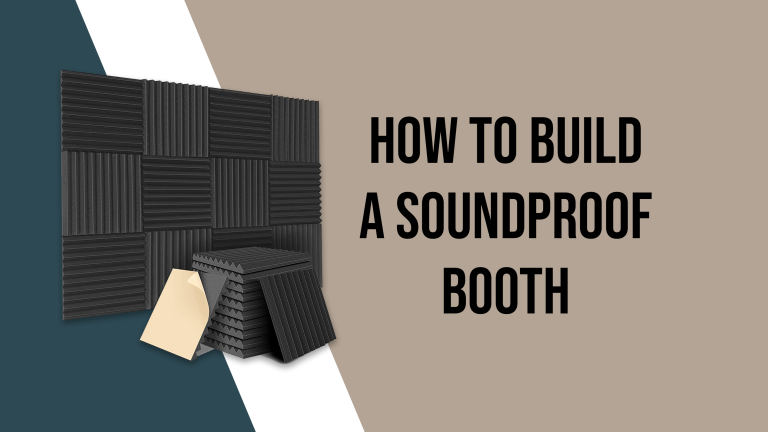Soundproof Box For Radon Fan: Whisper-Quiet Solution
Radon gas is a naturally occurring gas that is both odorless and tasteless. It is commonly found in the soil and can seep into homes through cracks in the foundation or other openings. Long-term exposure to radon gas can be dangerous, as it has been linked to lung cancer.
Installing a radon fan is one of the most effective ways to reduce the level of radon gas in your home. However, these fans can be loud and disruptive, which is why a soundproof box is a great solution for those who want a quieter radon mitigation system.
Soundproof Box For Radon Fan
You often soundproof:
- Barn Door
- Hollow Door
- Closet
- Drop Ceiling
- Hotel Rooms
- Hurricane Windows
- Baby Room
- Basement
- Furnace Closet
- Mobile Home
- Apartment
- Floor Tiles
- Dog Crate
The Radon fan cover box is designed with sound-absorbing materials and a double-walled structure, which helps to prevent sound from escaping. Easy installation and increased home value are also benefits of using a soundproof box for a noisy radon fan.
What is a Radon Fan?
A radon fan is a type of ventilation system that is installed to reduce the levels of radon gas in a home. Radon fans work by creating negative pressure in the crawlspace or basement, which pulls radon gas out of the soil and exhausts it to the outside.
This whole mechanism is called the Radon mitigation system.
Are Radon Mitigation Systems Noisy?
Yes, a Radon mitigation system can be noisy. Radon fans are effective at improving indoor air quality, but they can also be noisy, especially if they are located in a living space.
Even brand-new Radon fans produce a noticeable whooshing sound that’s hard to ignore. Moreover, depending on the quality of the Radon fan, it can be louder or quieter. Cheap fans that are made up of cheap materials will produce louder noises. Premium quality fans are much less noisy.
Overtime, the Radon fans wear out. The motor, bearings, and other parts can corrode over time and cause loud noises. In those cases, it’s best to replace the parts or the fan as whole.
If a new Radon mitigation system seems too loud, a soundproof Radon fan box can help.
Read on to learn how to reduce Radon fan noise via soundproofing.
Why Use a Soundproof Box for Radon Fan?
If you have a radon fan installed in your home, you may be dealing with noise pollution from the fan. A soundproof box can help reduce the noise levels of your radon fan, making it more tolerable to live with.
Soundproof boxes are designed to block sound waves and reduce the amount of noise that escapes. By installing a soundproof box for your radon fan, you can greatly reduce the amount of noise that is produced, and get rid of the intolerable radon mitigation system noise.
How to Choose the Right Soundproof Box for Your Radon Fan?
When choosing a soundproof box for your radon fan, there are several factors to consider. The first factor is the size of the box, which needs to be large enough to accommodate your fan. You should also consider the material of the box, as different materials have different levels of soundproofing.
For example, a box made from solid materials like metal or dense foam is going to be more effective at blocking sound than a box made from lightweight materials like cardboard.
Another important factor is the type of fan that you have. Different fans have different noise levels, so you should choose a soundproof box that is specifically designed for your type of fan. This will ensure that the box is able to effectively reduce the noise levels of your fan.
Finally, you should consider the installation process. Some soundproof boxes are easy to install, while others may require professional assistance. If you are not comfortable with installation, you should choose a soundproof box that comes with clear instructions and is easy to install.
How Does a Soundproof Box Work?
A soundproof box works by blocking sound waves and reducing the amount of noise that escapes. This is achieved through the use of sound-absorbing materials, such as dense foam or mass loaded vinyl. These materials are placed inside the box to absorb and dissipate the sound waves, reducing the amount of noise that escapes.
Additionally, the design of the box itself can play a role in reducing noise. Some soundproof boxes are designed with a double-walled structure, which helps to prevent sound from escaping. Others may have a dampening layer between the walls, which further reduces noise.
Soundproof Box for Radon Pump
A soundproof box for a radon pump is designed to reduce the noise created by the pump when it is in operation. If your Radon system is making noise, a soundproof box for Radon pump can help.
The box is typically made of sound-absorbing materials and has a double-walled structure that helps to prevent sound from escaping. The soundproof box fits over the radon pump, reducing the amount of noise that is emitted and making it more tolerable to live with.
The use of a soundproof box is particularly important for those who have radon pumps installed in their homes, as the constant noise can be disruptive to daily life. By installing a soundproof box, homeowners can enjoy a quieter environment and reduced noise levels.
Benefits of a Soundproof Box for Radon Fan
There are several benefits to using a soundproof box for your radon fan. These include:
Reduced Noise Levels:
The main benefit of a soundproof box is that it reduces the noise levels of your radon fan, making it more tolerable to live with.
Improved Air Quality:
By reducing the noise levels of your radon fan, you can also improve the air quality in your home. The fan will be able to operate more efficiently, reducing the levels of radon gas and improving the overall air quality in your home.
Increased Energy Efficiency:
A quieter fan will use less energy, as it will not need to work as hard to overcome the noise. This can result in lower energy bills and a more energy-efficient home.
Increased Home Value:
By reducing the noise levels of your radon fan, you can also increase the value of your home. A quiet and efficient radon mitigation system can be a selling point for potential buyers.
Easy Installation:
Many soundproof boxes are designed to be easy to install, even for those without professional experience. This can save you money on installation costs and ensure that your radon fan is up and running as soon as possible.
Why is my Radon system So Loud?
Sometimes, even a newly installed Radon system can sound very loud. But there’s no debris, no faulty equipment, so what can cause a new Radon system to be loud? Well, here’s a couple of reasons:
Poor Mounting
The internal motor of the Radon fan that runs the whole Radon mitigation system is a powerful one. It produces heavy vibrations that can come in contact with its surroundings and produce noise. However, if the Radon fan is mounted correctly and doesn’t come in contact with any wall or floor, these vibrations get suppressed. So, if you’re experiencing louder than usual noise from your Radon mitigation system, check and see if it’s properly mounted.
Fan Size/Quality
Radon fans come in different sizes and qualities. If a Radon fan is too big for the Radon mitigation system, it will generate louder whirring sounds all across the Radon vents. Similarly, poor quality fans that have imbalance fan blades can also add to the Radon mitigation system noise.
Why is my Radon System Making Noise?
Radon mitigation systems are a bit noisy by default. Even if the Radon system is in perfect condition, you’ll continuously hear the airflow noise and noise produced by equipment vibrations.
That said, if you think your Radon system is noisier than usual, it could be due to one of the following reasons:
Faulty Fan
If your Radon system is producing a loud humming or whirring noise, it’s because the Radon fan has run its course and needs to be replaced. Radon fans have a life span of 5 -15 years, depending on the build quality and the internal material. Over time, due to running constantly, the motor of a Radon fan gets slower and louder. As a result, the Radon fan pumps less air around but produces louder noises. Check the manometer to see how the fan is performing in terms of airflow. If it’s below the normal reading, it’s time to replace the fan.
Debris/Blockage
The Radon mitigation system needs proper cleaning, repairs, and maintenance. The pipes and the fan must be cleaned regularly to prolong their life and improve their performance. If you don’t maintain your Radon mitigation system, debris can start to build up in the pipes and around the fans. This can result in a louder radon mitigation system and affect the performance as well.
Thankfully, there are ways to make your Radon mitigation system quieter.
How To Quiet Radon Fan?
Radon fans provide better indoor air quality but increase indoor noise pollution as well. To effectively pump out the Radon and improve indoor quality, a Radon mitigation system uses a fan to push out Radon concentrations through pipes.
Naturally, the fan’s motor and blades produce a sound when running. While it’s not excessively loud, the fan does produce a noticeable sound that gets amplified if the walls are poorly insulated.
Thankfully, there are plenty of ways to quiet down a Radon fan.
Change The Fan Position:
Most of the time, a Radon fan appears too loud only because it’s placed in near a hollow wall. The sound and vibrations generated by the Radon fan get amplified in the hollow walls and spread across the whole house, making an unbearable noise around the house. In this case, simply repositioning your Radon fan can significantly reduce its noise.
Use Soundproofing Cover For Radon Fan:
Another way to reduce the noise and quite a noisy Radon fan is by using a soundproofing box or cover for the Radon fan. Soundproof boxes specially made for Radon fans are readily available in the market.
A soundproof Radon fan box uses sound-dampening material like foam or plywood to absorb and dissipate sound waves generated by the Radon fan. They dampen the loud noise of the fan’s motor, significantly reducing the overall noise of the fan.
And that’s how to make the Radon fan quieter. None of these methods will completely silence the fan, but they certainly reduce the decibel levels enough so that it’s no longer disruptive.
FAQ’s
How do you soundproof a radon fan?
A radon fan can be soundproofed by using a soundproof box. The box is designed with sound-absorbing materials and a double-walled structure, which helps to prevent sound from escaping. The soundproof box fits over the fan, reducing the amount of noise that escapes and making the radon fan more tolerable to live with.
Do radon fans make noise?
Yes, radon fans can make noise. The level of noise can vary depending on the type of fan and the specific circumstances in which it is being used. Some radon fans are louder than others, and the sound they produce can be influenced by factors such as the location of the fan, the size of the room, and the ventilation system.
How do you vent a radon fan?
A radon fan can be vented through a pipe or duct that leads to the outside of the building. The pipe or duct should be installed to ensure proper ventilation, so that radon gas can be expelled from the building. A professional contractor should be consulted to ensure that the radon fan is properly vented.
Should radon fan run all the time?
Yes, a radon fan should run all the time to reduce the levels of radon gas in the home. The fan operates continuously, expelling radon gas from the building and helping to improve the air quality inside.
Why is radon fan so loud?
A radon fan can be loud for several reasons, including poor insulation or ventilation, a lack of soundproofing, or a poorly designed fan. The level of noise can also be influenced by factors such as the size of the room and the location of the fan.
How do you soundproof a fan?
A fan can be soundproofed by using a soundproof box or by installing sound-absorbing materials such as acoustic foam or fiberglass insulation. The soundproof box should fit over the fan, reducing the amount of noise that escapes. Alternatively, sound-absorbing materials can be installed near the fan to reduce the level of noise it produces.
Are radon fans explosion proof?
Not all radon fans are explosion proof. The explosion-proof rating of a fan will depend on the manufacturer and the specific model. If you are concerned about the safety of your radon fan, it is important to choose a model that meets your safety requirements.
Does airflow reduce radon?
Yes, airflow can help to reduce radon levels by improving ventilation and expelling radon gas from the building. A radon fan operates by continuously expelling radon gas from the building, improving the air quality and reducing the levels of radon gas.
Should radon vent be covered?
A radon vent should not be covered. The vent should remain open to ensure proper ventilation, so that radon gas can be expelled from the building. If the vent is covered, it can prevent the radon fan from operating properly, reducing its effectiveness and increasing the levels of radon gas in the home.
Does radon fan reduce humidity?
A radon fan can help to reduce humidity by improving ventilation and expelling moisture-laden air from the building. This can help to reduce the levels of moisture in the home, which can help to reduce the risk of mold growth and improve the overall air quality.
How many years does a radon fan last?
The lifespan of a radon fan will depend on the specific model and the conditions in which it is being used. Some radon fans can last for several years, while others may need to be replaced sooner. On average, a radon fan can last anywhere from 5 to 15 years, but this will vary based on factors such as the quality of the fan, the conditions in which it is being used, and the level of maintenance it receives.
It is important to regularly inspect and maintain your radon fan to ensure it continues to operate properly and efficiently.
Should radon fan be inside or outside?
A radon fan can be installed either inside or outside of the building, depending on the specific circumstances and the preferences of the homeowner. If the fan is installed inside, it should be placed in a location that is easily accessible for maintenance and inspection. If the fan is installed outside, it should be protected from the elements and placed in a location that is accessible for maintenance and inspection.
A professional contractor should be consulted to determine the best location for the radon fan based on your specific needs and circumstances.
Conclusion
A soundproof box for your radon fan is a great solution for those who want a quieter and more efficient radon mitigation system. With a soundproof box, you can reduce the noise levels of your fan, improve the air quality in your home, and increase the value of your home. By considering the factors outlined above, you can choose the right soundproof box for your radon fan and enjoy the many benefits it has to offer.








